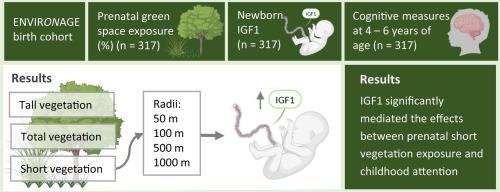Prenatal green space exposure and child’s cognition: mediation by cord blood IGF1 in the ENVIRONAGE birth cohort
IF 9.7
1区 环境科学与生态学
Q1 ENVIRONMENTAL SCIENCES
引用次数: 0
Abstract
Background
Green space exposure has been linked to improved cognitive functioning over the life course. We examined whether newborn insulin-like growth factor 1 (IGF1) plays a part in this.Methods
We measured cord blood plasma IGF1 in 317 mother–child pairs from the ENVIRONAGE birth cohort. Prenatal green space exposure was assessed within several radii (50–1000 m) around the maternal residence. Multivariable linear regression models were used to associate IGF1 levels with green space exposure. Cognitive functioning was assessed at follow-up at 4 to 6 years of age, using the Cambridge Neuropsychological Test Automated Battery (CANTAB), and converted to components by principal component analysis. Mediation analysis was conducted to examine the relationship between green space exposure and cognitive functioning, with IGF1 as a mediator.Findings
Prenatal short vegetation (<3 m in height) exposure associated with newborn IGF1 within 50, 100 and 1000 m (P ≤ 0.05), and newborn IGF1 significantly predicted the neurocognitive domain of attention/psychomotor speed during childhood (P < 0.01). Newborn IGF1 significantly mediated the association between prenatal short vegetation exposure and the latencies of the Motor Screening task and the Big/Little Circle task: Per IQR increase in short vegetation within 50 m, the latencies decreased by 0.45 % (95 % CI: −0.986 to −0.047, P = 0.014) and 0.48 % (95 % CI: −1.164 to −0.016, P = 0.044) via IGF1.Interpretation
Residential surrounding green space during pregnancy may be associated with long-lasting cognitive benefits for the child, mediated through higher cord blood IGF1 protein levels at birth.

产前绿地暴露与儿童认知:脐带血IGF1在ENVIRONAGE出生队列中的中介作用
在生命过程中,接触绿色空间与改善认知功能有关。我们研究了新生儿胰岛素样生长因子1 (IGF1)是否在其中起作用。方法我们测量了来自enviage出生队列的317对母子的脐带血血浆IGF1。在产妇住所周围的几个半径(50-1000 m)范围内评估产前绿地暴露情况。使用多变量线性回归模型将IGF1水平与绿地暴露联系起来。在4至6 岁的随访中,使用剑桥神经心理测试自动化电池(CANTAB)评估认知功能,并通过主成分分析将其转换为成分。以IGF1为中介,对绿地暴露与认知功能之间的关系进行了中介分析。发现产前短植被(身高<;3 m)暴露与新生儿IGF1在50、100和1000 m范围内相关(P ≤ 0.05),新生儿IGF1显著预测儿童时期注意/精神运动速度神经认知域(P <; 0.01)。新生儿IGF1显著介导产前短植被之间的关系曝光和电动机的延迟筛查任务和大/小圆任务:每短差增加植被在50 m,延迟下降了0.45 %(95 % CI: 0.986−−0.047,P = 0.014)和0.48 %(95 % CI: 1.164−−0.016,P = 0.044)通过IGF1。怀孕期间居住在绿色空间周围可能与孩子长期的认知益处有关,这是通过出生时较高的脐带血IGF1蛋白水平介导的。
本文章由计算机程序翻译,如有差异,请以英文原文为准。
求助全文
约1分钟内获得全文
求助全文
来源期刊

Environment International
环境科学-环境科学
CiteScore
21.90
自引率
3.40%
发文量
734
审稿时长
2.8 months
期刊介绍:
Environmental Health publishes manuscripts focusing on critical aspects of environmental and occupational medicine, including studies in toxicology and epidemiology, to illuminate the human health implications of exposure to environmental hazards. The journal adopts an open-access model and practices open peer review.
It caters to scientists and practitioners across all environmental science domains, directly or indirectly impacting human health and well-being. With a commitment to enhancing the prevention of environmentally-related health risks, Environmental Health serves as a public health journal for the community and scientists engaged in matters of public health significance concerning the environment.
 求助内容:
求助内容: 应助结果提醒方式:
应助结果提醒方式:


